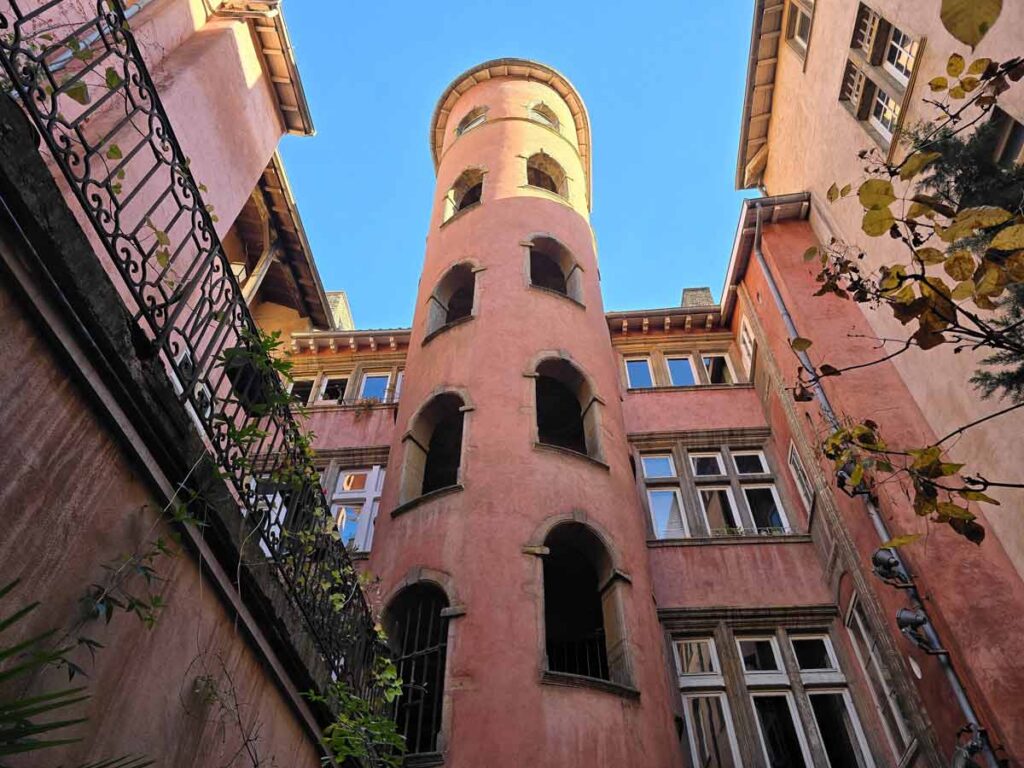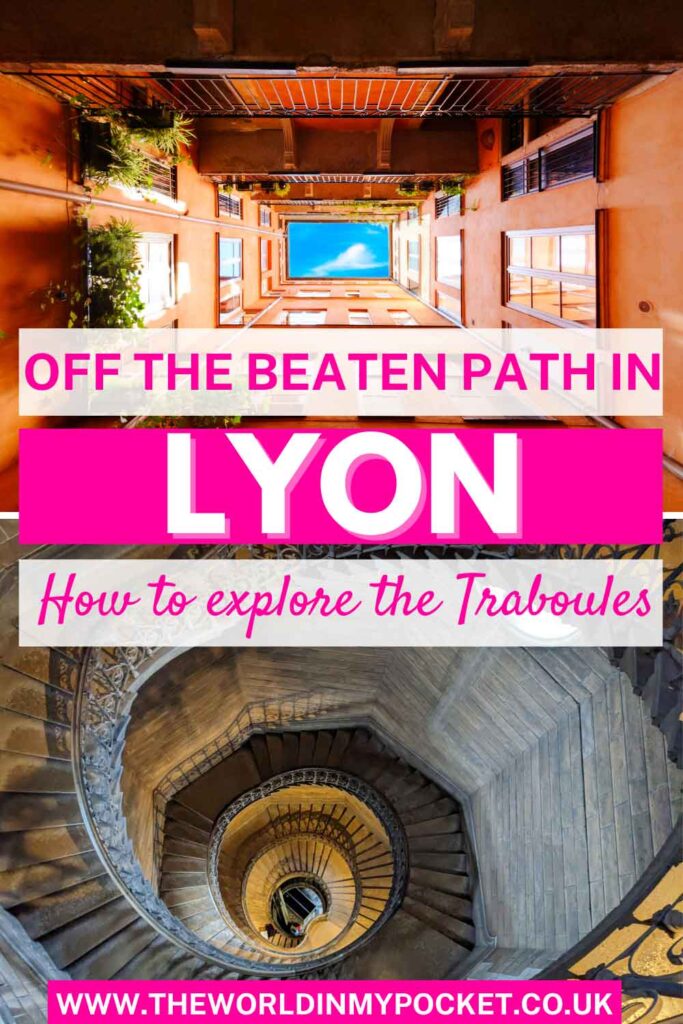My first visit to Lyon was everything I hoped it would be: beautiful architecture, incredible food, and that effortless French charm around every corner. But there was one thing I left feeling disappointed about: I didn’t get to visit the traboules of Lyon.
If you’ve done even a little research about Lyon, you’ve probably come across these mysterious passageways tucked behind unassuming doors in Vieux Lyon and Croix-Rousse. The traboules are such an iconic part of the city’s history, used by silk workers, secret couriers during WWII, and everyday locals navigating the maze-like streets. But as a tourist? I had no idea how to find them, let alone how to get in. The traboule tour I found online didn’t run on the days I was in town, and with such a short visit, I simply couldn’t make it work. I left feeling like I’d missed something really special.

Fast forward to my second trip to Lyon, and this time, I cracked the code.
I’m here to tell you how you can visit the traboules in Lyon, even without a tour of a guide. Because once you know what to look for, the doors all of a sudden open quietly open up.
There are two main areas in Lyon where you’ll find traboules: the cobbled lanes of Vieux Lyon and the hilly, bohemian neighbourhood of Croix-Rousse. Funny enough, my first ever traboule experience happened completely by accident. While wandering the streets of Croix-Rousse, I spotted an open door with a small historic plaque beside it. Curious, I stepped inside, and found myself in a tucked-away courtyard, facing a huge staircase with a rather grey, brutalist architecture. I watched a few people descend into what looked like a basement, so I followed… and emerged in another courtyard, then another, and eventually on an entirely different street. It was like the hill had its own hidden underground network, and I’d just stumbled into it.
Naturally, I tried to do the same thing in Vieux Lyon, but no luck. Closed doors and no clues. What I didn’t know then was that there is a way in—you just have to know how. On my return trip, armed with a bit more local knowledge and curiosity, I finally discovered the secret to seeing Lyon’s traboules on your own.
And I’m going to share everything I’ve learned—so you won’t miss them like I did the first time.
What is a Traboule?

Imagine stepping through what looks like an ordinary wooden door on a quiet Lyon street—maybe one of those heavy ones with a brass knob and a bit of wear around the edges—and instead of finding a hallway or someone’s foyer, you’re suddenly walking through a hidden courtyard. A few more steps, and you’re twisting through a spiral staircase, brushing past massive walls, maybe catching sight of a turret above you or a tiny sculpted face staring from a corner. Then, just as suddenly, you emerge onto a completely different street. Welcome to the world of traboules!
The word traboule is unique to Lyon, and comes from the Latin trans ambulare, meaning “to pass through.” Which is exactly what you’re doing: passing through buildings, rather than around them. These secret passageways are like a hidden web beneath the city’s surface, linking one street to another via private courtyards, Italian-style galleries, and sometimes even tiny gardens you’d never suspect were there.
Walking a traboule feels a little like having insider access to the city’s most secret corners. They were once used by silk workers to transport goods without braving the rain (or nosy eyes), and later by members of the French Resistance during WWII. Today, they’re a magical little glimpse into Lyon’s layered past, as well as a fun challenge for the modern wanderer. Just remember: not all doors open, but half the fun is in the search.
The History of Traboules

Traboules aren’t just quirky architectural shortcuts; they’re part of Lyon’s DNA. These secret passageways date back as far as the 4th century, when the city, then known as Lugdunum, was expanding down from the Fourvière hill towards the riverbanks. Back then, water was life, and the Saône was the source. The earliest traboules were built so residents could get to the river quickly, without having to weave through the maze of narrow streets above.
But it wasn’t until the Renaissance that traboules really flourished, especially in the Vieux Lyon and Croix-Rousse neighbourhoods. Lyon had become a silk capital, and those beautiful, airy courtyards and covered walkways weren’t just aesthetic— they were practical. The canuts, Lyon’s silk workers, used the traboules to transport delicate rolls of silk from their workshops to merchants, keeping them dry and safe from the elements. No one wanted water-stained silk.
Fast forward a few centuries, and these same passageways took on a much more serious role during World War II. The traboules became secret routes for members of the French Resistance, allowing them to move unseen through the city, evade German patrols, and organise underground meetings. The Nazis quickly learned that chasing a rebel into a traboule didn’t mean they’d catch them.
So while today they may just seem like charming architectural oddities, traboules have been lifelines: for silk, for strategy, and for the soul of the city itself.
The Best Traboules in Lyon

There are more than 500 traboules hidden in Lyon’s twisting streets—200 in Vieux-Lyon alone, 160 snaking through the slopes of Croix-Rousse, and 130 scattered around the Presqu’île. But before you start daydreaming about disappearing through secret doors all day, here’s the catch: only around 80 are actually open to the public. The rest are behind locked gates, private residences, or just plain impossible to find unless you have a local friend or a very patient cat burglar on speed dial.
The Best Traboules in Vieux Lyon
Even with so many traboules, what’s accessible is more than enough to keep you spellbound. Here are some of the most beautiful and historically rich traboules in Vieux-Lyon, the Renaissance heart of the city, with pastel facades and cobbled streets.
📍 27 rue Saint-Jean to 6 rue des Trois-Maries
This one’s a classic. It passes through two inner courtyards framed by bright, restored 16th-century galleries. The plasterwork shines in the sunlight, and if you catch it just right in the morning, the shadows of the arches fall like lace across the stone floor. It’s the kind of place you want to linger, if only for a few quiet moments.
📍 La Maison des Avocats, rue de la Bombarde
Tucked behind this building is a little courtyard known as La Basoche, once a garden and meeting place for Lyon’s legal guild. These days, it feels like a hidden pocket of calm, perfect if you want to escape the tourist buzz for a moment of peace.
📍 La Maison du Chamarier, 37 rue Saint-Jean
More than just a beautiful courtyard, this house belonged to the Chamarier, an important figure in the archbishop’s court. Today, you can peek into its Gothic soul via its richly detailed architecture—arched windows, carved stonework, and a certain gravity that hints at its once high-ranking occupant.
📍 Galerie Philibert de l’Orme, Maison Bullioud, 8 rue Juiverie
This one’s a showstopper. Designed by famed French Renaissance architect Philibert de l’Orme, the gallery features a twisting, almost surreal stone passageway, unlike anything else in Lyon. If there’s one traboule that makes you gasp out loud, it’s this one.
📍 10 & 12 rue Saint-Georges
This traboule opens up into a serene little garden that feels more Provençal than Lyonnais. It’s the perfect spot for a morning wander when the city is still stretching awake.
📍 La Longue Traboule: 54 rue Saint-Jean to 27 rue du Bœuf
As the name suggests, this is the longest traboule in the neighbourhood. It crosses four courtyards and just as many buildings. Walking it feels a bit like being in a movie—each doorway opens up to something different: a winding staircase here, a wrought iron balcony there. You half expect a 17th-century silk weaver to brush past you in a hurry.
📍 2 Place du Gouvernement to 10 quai Romain Rolland
Now here’s a story: this 15th-century building once housed the Hostellerie St Christopher, a stopover for travellers arriving by river. The Gothic flourishes on the facade give away its age, but it’s the traboule that tells the tale—leading from the upper stables down toward the docks, once guiding horses, carriages, and their riders toward the court above.
📍 40 rue Saint-Jean to 5 Place Neuve Saint-Jean
This passage offers a lovely mix of old and older, start from the Rue Saint-Jean side and wind your way through courtyards that carry the scent of history (and sometimes croissants). It’s one of the more photographed ones, and for good reason.
📍 14 rue du Bœuf (courtyard only)
A bit of a hidden gem, this courtyard is less grand but utterly charming, especially when the sun hits the warm-toned walls. If you’re lucky, you might find it blissfully empty—just you and the quiet hum of centuries past.
The Best Traboules in Croix-Rousse

If Vieux-Lyon is all Renaissance romance and postcard charm, Croix-Rousse is its scruffier, more rebellious cousin. Still beautiful, but with a bit of an edge. Perched on the hill above the city, this was once the bustling domain of the canuts, Lyon’s legendary silk workers. Their fight for fair pay and better working conditions in the 19th century gave Croix-Rousse a working-class soul that still lingers in its steep staircases, bohemian cafés, and—of course—its traboules.
There are around 160 traboules criss-crossing the slopes here, many of them vertical rather than horizontal, linking streets at dramatically different elevations with towering staircases and narrow alleyways. Here’s where to find the most captivating ones:
📍 9 Place Colbert → 29 rue Imbert-Colomès & 14 bis montée St Sébastien
This is the traboule to see in Croix-Rousse. Known as the Cour des Voraces (literally, “Court of the Voracious”), its name comes from a radical group of silk workers who helped ignite the Canut Revolts in 1848. It’s got serious historical weight, and the architecture to match. The six-story facade with its open-air staircase is as dramatic as any opera set, and just as full of stories.
📍 Passage Thiaffait: 30 Rue Burdeau → 19 Rue Leynaud
Once a silk passage, now a haven for Lyon’s indie designers and artists. This traboule buzzes with creativity. Fashion ateliers, jewellery makers, and artists’ studios now line the path, making it feel more like a tiny creative village than a secret passageway. If you’re looking for inspiration (or a one-of-a-kind souvenir), this is the place.
📍 5 Rue Coustou → 22 Rue des Capucins
This one might win the award for “most photogenic.” A narrow passage opens onto a charming interior with a wrought-iron staircase curling its way up like something out of a romantic French film. All it’s missing is an accordion soundtrack.
📍 20 Rue Imbert-Colomès → 55 Rue des Tables Claudiennes
A beautiful route that’s still wonderfully under the radar. It winds through classic Croix-Rousse terrain, modest facades hiding intricate interiors, and drops you right into the heart of a lesser-known part of the district.
📍 Cour du Moirage: 5 Place Croix-Paquet → 3 bis Petite Rue des Feuillants
This traboule is all elegance. Stone archways, clean lines, and a sense of airy refinement make it one of the most graceful passageways in Croix-Rousse. It doesn’t shout for attention—it simply waits for you to appreciate its understated beauty.
📍 118 Montée de la Grande Côte → 7 rue Terme
You’ll feel like you’ve stumbled upon a secret with this one. It’s tiny, almost like it’s hiding from the world. Blink and you might miss it—which is half the fun.
📍 Venelle des Pierres Plantées
Bucolic and blissfully quiet, this little path winds gently downhill past a school and into a leafy garden. It’s less about architectural grandeur and more about the slow, reflective pleasure of walking somewhere that feels like it’s been forgotten by time, and tourists.
📍 4 Rue de Thou → 5 Petite Rue des Feuillants
Another stunner, this traboule features one of the most impressive staircases in the area. Monumental and grand, it offers a sense of scale and drama you wouldn’t expect from a simple passage between two quiet streets.
📍 6 Rue René Leynaud → 3 Rue des Capucins
This one surprises you with its sudden shift from the ordinary to the picturesque. It’s short, but sweet—especially when you catch it in the golden light of late afternoon.
📍 6 Rue des Capucins → 1 Rue Sainte-Marie des Terreaux
Finishing strong with one of the largest courtyards in the traboule world. It opens up in a way that makes you stop mid-step, surprised by how much space hides behind such unassuming facades.
How to Visit the Traboules in Lyon

The traboules may feel like secret passages, but their continued accessibility is actually the result of a very public agreement. In 1990, the City of Lyon struck a deal with private property owners to preserve this unique piece of the city’s heritage. Known as the Courtyard and Traboule Agreement, it allows public access to certain traboules and courtyards between 7 am and 7 pm every day—in exchange for the city contributing to maintenance, lighting, and cleaning costs.
Not all traboules are open, and understandably so. Many residents have invested heavily in restoring their historic buildings, and others have chosen to close the doors to preserve peace and cleanliness. But thanks to this agreement, around 80 traboules remain accessible—provided visitors treat them with the respect they deserve.
You’ll know a traboule is open to the public if you spot a small brown plaque near the entrance, usually with the words “traboule ouverte au public” or similar. These markers mean you’re free to enter—quietly and respectfully.
Visiting With a Tour

If it’s your first time in Lyon, I highly recommend seeing the traboules on a guided tour. I discovered the traboules of Vieux-Lyon by booking a fantastic walking tour via GetYourGuide (click here to see the tour). It was not only informative but genuinely fun. The guide shared stories I’d never have found on my own, from tales of the silk workers to little-known Resistance facts from WWII.
The tour took us through some of the most famous traboules in the old town, with plenty of time to admire the spiral staircases, inner courtyards, and hidden details I might have walked straight past.
Exploring on Your Own

Of course, you can also explore the traboules independently, and it’s still a magical experience, even without a guide. Not all tours run every day, and if you find yourself in Lyon on a quiet Tuesday or off-season weekend, there’s nothing stopping you from wandering the city’s oldest streets and discovering its hidden corners yourself.
So how do you actually open a traboule door? It’s easier than you might think. At the main entrance, you’ll see a buzzer panel listing apartment numbers. Look toward the bottom—there’s often a single, unmarked button. Just press that one. No need to ring a resident or try your luck with random numbers. That little button is your golden key.
But remember: these are still private residences. Locals live here. Children play in these courtyards. Washing hangs from balconies. The fact that you can pass through them is a privilege, not a right. So keep your voice low, don’t litter, and absolutely no shouting or running. The quieter you are, the more likely it is that these passageways will stay open for others to enjoy, just as you are now.
Final Thoughts on Visiting Lyon’s Traboules

Exploring the traboules of Lyon feels a bit like finding out a secret that only the locals know about. Behind those heavy wooden doors and quiet facades are layers of history, beautiful architecture, and stories that most tourists walk right past without even knowing they’re there.
Discovering these passageways, on your own or with a guide, is one of the most unique things you can do in Lyon. It’s part treasure hunt, part time machine.
But as magical as they are, traboules are also part of real people’s homes. So if you choose to explore them independently, remember to tread lightly. Keep your voice down, don’t linger too long, and definitely don’t treat them like a photo shoot location. The very reason these passageways remain open is because of the trust between the city and its residents. Let’s help keep it that way.
Lyon will charm you with its gastronomy, its charm, and its elegant riverfronts, but it’s the traboules that might just make you fall in love.
For more articles about Lyon, check out my recommendations below:
Like it? Pin it!

Disclaimer: Some of the links on this website are “affiliate links.” This means that if you click on the link and do a purchase, I will receive an affiliate commission at no extra cost for you. This helps me keep my website running and continue to share my travelling knowledge with you. I thank you for booking your flights or hotels using the links on my website. Regardless, I only recommend products or services I use personally and believe will add value to my readers.




